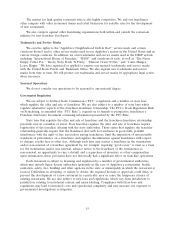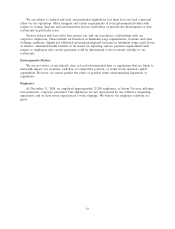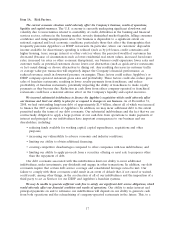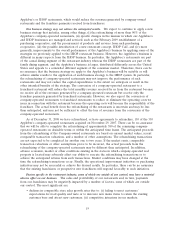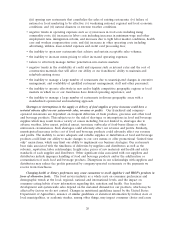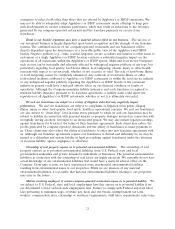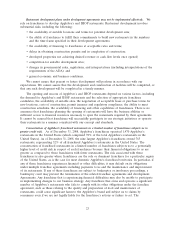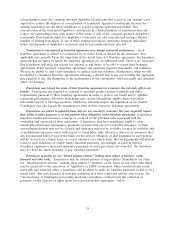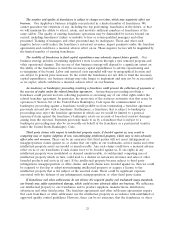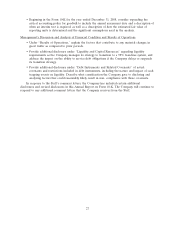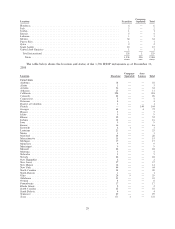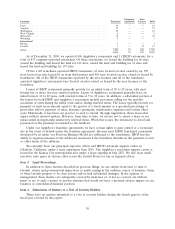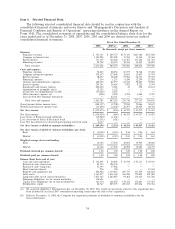IHOP 2008 Annual Report Download - page 38
Download and view the complete annual report
Please find page 38 of the 2008 IHOP annual report below. You can navigate through the pages in the report by either clicking on the pages listed below, or by using the keyword search tool below to find specific information within the annual report.refranchising of most the company-operated Applebee’s restaurants that is part of our strategy is not
expected to reduce the degrees of concentration of franchised Applebee’s restaurants because the
existing franchisees are the likely candidates to acquire company-operated restaurants. The
concentration of the franchised Applebee’s restaurants in a limited number of franchisees may also
reduce our negotiating power with respect to the terms of sale of the company-operated Applebee’s
restaurants. Development rights for Applebee’s restaurants are also concentrated among a limited
number of existing franchisees. If any of these existing franchisees experience financial difficulties,
future development of Applebee’s restaurant may be materially adversely affected.
Termination or non-renewal of franchise agreements may disrupt restaurant performance. Each
franchise agreement is subject to termination by us in the event of default by the franchisee after
applicable cure periods. Upon the expiration of the initial term of a franchise agreement, the franchisee
generally has an option to renew the franchise agreement for an additional term. There is no assurance
that franchisees will meet the criteria for renewal or will desire or be able to renew their franchise
agreements. If not renewed, a franchise agreement, and payments required thereunder, will terminate.
We may be unable to find a new franchisee to replace such lost revenues. Furthermore, while we will
be entitled to terminate franchise agreements following a default that is not cured within the applicable
grace period, if any, the disruption to the performance of the restaurants could materially and adversely
affect our business.
Franchisees may breach the terms of their franchise agreements in a manner that adversely affects our
brands. Franchisees are required to conform to specified product quality standards and other
requirements pursuant to their franchise agreements in order to protect our brand and to optimize
restaurant performance. However, franchisees may receive through the supply chain or produce
sub-standard food or beverage products, which may adversely impact the reputation of our brands.
Franchisees may also breach the standards set forth in their respective franchise agreements.
Franchisees are subject to potential losses that are not covered by insurance that may negatively impact
their ability to make payments to us and perform other obligations under franchise agreements. Franchisees
may have insufficient insurance coverage to cover all of the potential risks associated with the
ownership and operation of their restaurants. A franchisee may have insufficient funds to cover
unanticipated increases in insurance premiums or losses that are not covered by insurance. Certain
extraordinary hazards may not be covered and insurance may not be available (or may be available only
at prohibitively expensive rates) with respect to many other risks. Moreover, there is no assurance that
any loss incurred will not exceed the limits on the policies obtained, or that payments on such policies
will be received on a timely basis, or even if obtained on a timely basis, that such payments will prevent
losses to such franchisee or enable timely franchise payments. Accordingly, in cases in which a
franchisee experiences increased insurance premiums or must pay claims out-of-pocket, the franchisee
may not have the funds necessary to pay franchise payments.
Franchisees generally are not ‘‘limited purpose entities,’’ making them subject to business, credit,
financial and other risks. Franchisees may be natural persons or legal entities. Franchisees are often
not ‘‘limited-purpose entities,’’ making them subject to business, credit, financial and other risks which
may be unrelated to the operations of Applebee’s or IHOP restaurants. These unrelated risks could
materially and adversely affect a franchisee and its ability to make its franchise payments in full or on a
timely basis. Any such decrease in franchise payments may have a material adverse effect on us. See
‘‘An insolvency or bankruptcy proceeding involving a franchisee could prevent the collection of
payments or the exercise of rights under the related franchise agreement,’’ below.
24



